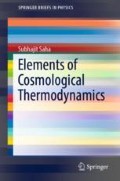Abstract
This chapter starts with the origin and a brief history of the application of the thermodynamic laws to (static) black holes and its subsequent generalization to Cosmology. The concepts of the generalized second law of thermodynamics, surface gravity and its connection with Hawking temperature, and Bekenstein entropy are carefully explained. Finally, the implications of the modified and the generalized Hawking temperatures are discussed with reference to the cosmological event horizon.
Access this chapter
Tax calculation will be finalised at checkout
Purchases are for personal use only
Notes
- 1.
The event horizon of a BH is the boundary which marks the limits of the BH. Anything (even light) that falls within the event horizon can never escape.
- 2.
The surface gravity can be defined as the local gravitational field strength experienced by a test particle at the surface of an astronomical body. This definition can be extended to include cosmological horizons as well. The surface gravity for a static or a stationary BH is a constant thanks to the zeroth law of BH thermodynamics, while in the case of a dynamic horizon relevant in the context of Cosmology, the surface gravity depends on the radius of the horizon as well as on its time derivative.
- 3.
Rindler horizons and Unruh temperatures are generally associated with accelerated observers in Minkowski spacetime of Special Theory of Relativity.
- 4.
A proof of this important fact can be found in Chap. 3 of the book by V. Faraoni (2015).
- 5.
The reader may go through Chap. 3 of the book by V. Faraoni for a detailed account of the MSH mass and its connection with the cosmological apparent horizon. This formalism was extended from BHs to the cosmological context by Bak and Rey (2000).
- 6.
We shall mostly consider the cosmological apparent and event horizons, however, arbitrary horizons may also be considered whenever necessary or relevant.
- 7.
The tensorial form of Eq. (3.9) is given by \(-dE_h=4\pi R_{h}^{2}T_{ab}\kappa ^{a}\kappa ^{b}dt\), where \(\kappa ^{\mu }\) is a null vector.
- 8.
A Bekenstein system is one which satisfies (in natural units) the Bekenstein entropy-mass bound \(S \le 2\pi RE\) as well as the Bekenstein entropy-area bound \(S \le \frac{A}{4}\), where S, R, E, and A are respectively the entropy, radius, energy, and area of the system.
References
Akbar, M., and R.G. Cai. 2006. Friedmann equations of FRW universe in scalar-tensor gravity, \(f(R)\) gravity and first law of thermodynamics. Physics Letters B 635: 7.
Bak, D., and S.J. Rey. 2000. Cosmic holography. Classical and Quantum Gravity 17: L83.
Bardeen, J.M., B. Carter, and S.W. Hawking. 1973. The four laws of black hole mechanics. Communications in Mathematical Physics 31: 161.
Bekenstein, J.D. 1973. Black holes and entropy. Physical Review D 7: 2333.
Bousso, R. 2002. The holographic principle. Reviews of Modern Physics 74: 825.
Bousso, R. 2005. Cosmology and the S-matrix. Physical Review D 71: 064024.
Brustein, R. 2000. Generalized second law in cosmology from causal boundary entropy. Physical Review Letters 84: 2072.
Cai, R.G., and S.P. Kim. 2005. First law of thermodynamics and Friedmann equations of Friedmann-Robertson-Walker universe. Journal of High Energy Physics 0502: 050.
Cai, R.G., L.M. Cao, and P. Hu. 2009. Hawking radiation of apparent horizon in a FRW universe. Classical and Quantum Gravity 26: 155018.
Chakraborty, S. 2012. Is thermodynamics of the universe bounded by the event horizon a Bekenstein system? Physics Letters B 718: 276.
Chakraborty, S. 2014. Generalized Bekenstein-Hawking system: Logarithmic correction. European Physical Journal C 74: 2876.
Davies, P.C.W. 1988. Cosmological horizons and entropy. Classical and Quantum Gravity 5: 1349.
Faraoni, V. 2015. Cosmological and Black Hole Apparent. Horizons, Springer.
Frolov, A.V., and L. Kofman. 2003. Inflation and de Sitter thermodynamics. Journal of Cosmology and Astroparticle Physics 05: 009.
Gong, Y., and A. Wang. 2007. Friedmann equations and thermodynamics of apparent horizons. Physical Review Letters 99: 211301.
Hawking, S.W. 1972. Black holes in general relativity. Communications in Mathematical Physics 25: 152.
Hawking, S.W. 1975. Particle creation by black holes. Communications in Mathematical Physics 43: 199.
Hayward, S.A. 1998. Unified first law of black-hole dynamics and relativistic thermodynamics. Classical and Quantum Gravity 15: 3147.
Jacobson, T. 1995. Thermodynamics of spacetime: The Einstein equation of state. Physical Review Letters 75: 1260.
Kodama, H. 1980. Conserved energy flux for the spherically symmetric system and the backreaction problem in the black hole evaporation. Progress of Theoretical and Experimental Physics 63: 1217.
Padmanabhan, T. 2002a. Thermodynamics of horizons: A comparison of Swarschild, Rindler and de Sitter spacetimes. Modern Physics Letters A 17: 923.
Padmanabhan, T. 2002b. Classical and quantum thermodynamics of horizons in spherically symmetric spacetimes. Classical and Quantum Gravity 19: 5387.
Padmanabhan, T. 2005. Gravity and the thermodynamics of horizons. Physics Reports 406: 49.
Paranjape, A., S. Sarkar, and T. Padmanabhan. 2006. Thermodynamic route to field equations in Lanczos-Lovelock gravity. Physical Review D 74: 104015.
Poisson, E. 2004. A relativist’s toolkit: The mathematics of black hole mechanics. Cambridge: Cambridge University Press.
Susskind, L. 1995. The world as a hologram. Journal of Mathematical Physics 36: 6377.
’t Hooft, G. 1993. Dimensional reduction in quantum gravity. arXiv:gr-qc/9310026.
Wald, R.M. 2001. The thermodynamics of black holes. Living Reviews in Relativity 4: 6.
Wang, B., Y. Gong, and E. Abdalla. 2006. Thermodynamics of an accelerated expanding universe. Physical Review D 74: 083520.
Suggested Further Reading
Black Hole Thermodynamics: Wald, R.M. 2001. The thermodynamics of black holes. Living Reviews in Relativity 4: 6; Carlip, S. 2014. Black hole thermodynamics. International Journal of Modern Physics D 23: 1430023.
Author information
Authors and Affiliations
Corresponding author
Rights and permissions
Copyright information
© 2018 The Author(s), under exclusive licence to Switzerland AG, part of Springer Nature
About this chapter
Cite this chapter
Saha, S. (2018). Cosmological Thermodynamics. In: Elements of Cosmological Thermodynamics. SpringerBriefs in Physics. Springer, Cham. https://doi.org/10.1007/978-3-319-74706-4_3
Download citation
DOI: https://doi.org/10.1007/978-3-319-74706-4_3
Published:
Publisher Name: Springer, Cham
Print ISBN: 978-3-319-74705-7
Online ISBN: 978-3-319-74706-4
eBook Packages: Physics and AstronomyPhysics and Astronomy (R0)

